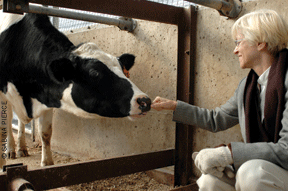
English bulldogs snore. A lot. Just ask Dr. Joan Hendricks V’79 Gr’80, the new dean of Penn’s School of Veterinary Medicine and the Henry and Corrine R. Bower Professor of Small Animal Medicine, who some 20 years ago found herself studying this drowsy breed.
She was working in the school’s sleep lab under Dr. Adrian Morrison, professor emeritus in animal biology, to learn more about sleep apnea and its potential treatments. People with this serious disorder stop breathing for short periods while they sleep—a condition that awakens them at frequent intervals and leaves them fatigued. As Hendricks found, bulldogs can suffer from it, too.
“We’d bring in these dogs who were pets into this strange room and we’d put all these belts on them and then walk out,” she recalls. “On average, they’d fall asleep in 12 minutes.” The non-bulldog control group was another matter. “They’d just bark and tear up the equipment and try to get out, and they’d do that for several hours until you give up.”
After a sabbatical spent in a neuroscience lab at the School of Medicine, Hendricks shifted her attention to another species, the fruit fly, doing pioneering work on the genetics of its sleep state. What fruit flies lack in cuteness, she explains, they make up for in quantity and low-maintenance lifestyle, “so the impact you can have [studying large numbers of them] is much greater.”
The role of dean brings another set of challenges—which may require spending less time with Drosophila and more with the state legislators who “see the point of the veterinary school and work hard to get us our funding.” But Hendricks is eager to get started. “It’s fun to be able to move on to something that again is really different,” she says.
Hendricks succeeds Dr. Alan Kelly, who was dean for 11 years before retiring. She has served as section chief of critical care in the clinical-studies department as well as founding director of the Veterinary Clinical Research Center. Hendricks also has a secondary appointment in the medical school.
“Her knowledge of Penn is broad and deep, her commitment to the [vet] school’s mission is passionate,” noted Penn President Amy Gutmann, adding that Hendricks “has distinguished herself equally in three areas vital to the school: research, education, and clinical service.”
As dean, Hendricks will oversee the opening this coming fall of the school’s new teaching and research building—named for Shirley and Vernon Hill W’67, who donated $10 million toward the project. The Hill Pavilion will be “a wonderful new teaching space” and will allow some of the school’s clinical- and basic-science researchers to work in more neighborly proximity, she says.
Working together is an important theme for Hendricks, who wants to build upon the vet school’s long history of cross-disciplinary research and has begun talking with the School of Medicine’s dean, Dr. Arthur Rubenstein, about ways to share information on mutually relevant projects and teaching opportunities.
“Our clinical patients often have the same diseases that people have, and there’s an awful lot to be learned from that as well as comparative biology,” she says. Along those lines, she would love to see a research database set up “across all the species … So [someone] would say, ‘I’m interested in this disease. I wonder how much of this they see in the vet school’—and just search the database and start to interact with us.”
Hendricks first knew she wanted to be a vet when she was eight. “It was 1960, and I was told ‘Girls aren’t vets’—and it was true.” She reclaimed this aspiration when she realized years later, as a pre-med student at Yale, that she was taking home all the mice and rats from the labs.
By then the profession had opened up, and Penn was admitting women in a number that was proportional to its applicant pool. Hendrick’s class was about 30 percent women. Today, she notes, 75 to 80 percent of vet-school applicants are women.
One trend she hopes to change is the prevalence of veterinary students interested in practicing pet medicine or “individual horse medicine. We do need those vets, and we need to train them,” Hendricks says. “But vets are the right people to be anywhere that animals and people interact—from these emerging diseases that go from animals to humans, to anything to do with food production … to wildlife management.” To encourage this, the school needs to create joint-training programs and recruit students who “want to help society in a wider way and have this strong connection to animals as well.”
The profession also needs support for student-debt relief, Hendricks says. “People enter with the thought that within four years they’ll be a vet, they’ll go into practice, and they’ll pay off their debts. If, to really fulfill society’s needs, it would be better if they got a master’s in public health or they did a fellowship working in farms abroad, they just don’t have the luxury of doing that.”
—S.F.




